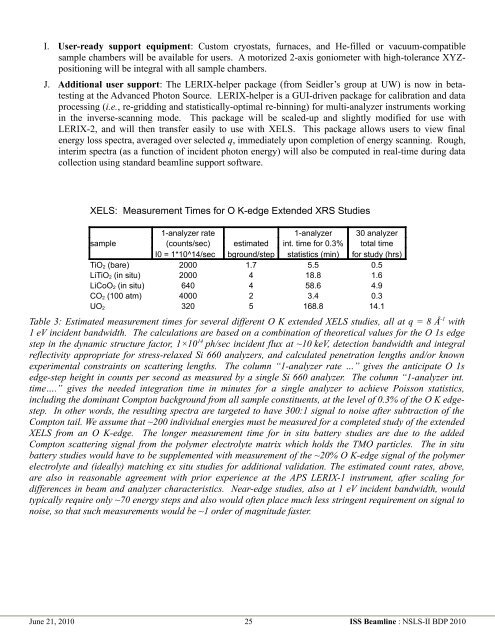Inner Shell Spectroscopy (ISS) - Brookhaven National Laboratory
Inner Shell Spectroscopy (ISS) - Brookhaven National Laboratory
Inner Shell Spectroscopy (ISS) - Brookhaven National Laboratory
Create successful ePaper yourself
Turn your PDF publications into a flip-book with our unique Google optimized e-Paper software.
I. User-ready support equipment: Custom cryostats, furnaces, and He-filled or vacuum-compatible<br />
sample chambers will be available for users. A motorized 2-axis goniometer with high-tolerance XYZpositioning<br />
will be integral with all sample chambers.<br />
J. Additional user support: The LERIX-helper package (from Seidler’s group at UW) is now in betatesting<br />
at the Advanced Photon Source. LERIX-helper is a GUI-driven package for calibration and data<br />
processing (i.e., re-gridding and statistically-optimal re-binning) for multi-analyzer instruments working<br />
in the inverse-scanning mode. This package will be scaled-up and slightly modified for use with<br />
LERIX-2, and will then transfer easily to use with XELS. This package allows users to view final<br />
energy loss spectra, averaged over selected q, immediately upon completion of energy scanning. Rough,<br />
interim spectra (as a function of incident photon energy) will also be computed in real-time during data<br />
collection using standard beamline support software.<br />
XELS: Measurement Times for O K-edge Extended XRS Studies<br />
1-analyzer rate 1-analyzer 30 analyzer<br />
sample (counts/sec) estimated int. time for 0.3% total time<br />
I0 = 1*10^14/sec bground/step statistics (min) for study (hrs)<br />
TiO2 (bare) 2000 1.7 5.5 0.5<br />
LiTiO2 (in situ) 2000 4 18.8 1.6<br />
LiCoO2 (in situ) 640 4 58.6 4.9<br />
CO2 (100 atm) 4000 2 3.4 0.3<br />
UO2 320 5 168.8 14.1<br />
Table 3: Estimated measurement times for several different O K extended XELS studies, all at q = 8 Å -1 with<br />
1 eV incident bandwidth. The calculations are based on a combination of theoretical values for the O 1s edge<br />
step in the dynamic structure factor, 1×10 14 ph/sec incident flux at ~10 keV, detection bandwidth and integral<br />
reflectivity appropriate for stress-relaxed Si 660 analyzers, and calculated penetration lengths and/or known<br />
experimental constraints on scattering lengths. The column “1-analyzer rate …” gives the anticipate O 1s<br />
edge-step height in counts per second as measured by a single Si 660 analyzer. The column “1-analyzer int.<br />
time….” gives the needed integration time in minutes for a single analyzer to achieve Poisson statistics,<br />
including the dominant Compton background from all sample constituents, at the level of 0.3% of the O K edgestep.<br />
In other words, the resulting spectra are targeted to have 300:1 signal to noise after subtraction of the<br />
Compton tail. We assume that ~200 individual energies must be measured for a completed study of the extended<br />
XELS from an O K-edge. The longer measurement time for in situ battery studies are due to the added<br />
Compton scattering signal from the polymer electrolyte matrix which holds the TMO particles. The in situ<br />
battery studies would have to be supplemented with measurement of the ~20% O K-edge signal of the polymer<br />
electrolyte and (ideally) matching ex situ studies for additional validation. The estimated count rates, above,<br />
are also in reasonable agreement with prior experience at the APS LERIX-1 instrument, after scaling for<br />
differences in beam and analyzer characteristics. Near-edge studies, also at 1 eV incident bandwidth, would<br />
typically require only ~70 energy steps and also would often place much less stringent requirement on signal to<br />
noise, so that such measurements would be ~1 order of magnitude faster.<br />
June 21, 2010 25 <strong>ISS</strong> Beamline : NSLS-II BDP 2010
















